Landslide Susceptibility Assessment Based on Multisource Remote Sensing Considering Inventory Quality and Modeling
Abstract
:1. Introduction
2. Research Data and Methods
2.1. Study Area
2.2. Data Sources
- (1)
- Remote-Sensing Data
- (2)
- Landslide-Influencing Factor Data
2.3. Methods
2.3.1. Remote-Sensing Technologies
- (1)
- Stacking InSAR
- (2)
- Satellite Remote-Sensing and UAV Technology
- (3)
- Multisource Remote-Sensing Technologies for Landslide Identification
2.3.2. Landslide Susceptibility Assessment
- Landslides from historical landslide inventories were utilized as disaster-point data for susceptibility assessment, and the IV, GWIV, and GLR models were constructed for susceptibility evaluation (Group I1).
- Landslides identified through multisource remote-sensing technologies in combination with landslides from historical landslide inventories were used as disaster-point data for susceptibility assessment, and the IV, GWIV, and GLR models were constructed for susceptibility evaluation (Group I2).
- (1)
- Information Value Model (IV)
- (2)
- Logistic regression Model (LR)
- (3)
- Random forest (RF) model
- (4)
- Genetic Algorithm (GA)
- (5)
- Coupling Model
3. Results
3.1. Landslide Inventory
- Historical inventory information, which consists of 353 landslide locations (the data were obtained based on the following project: The Implementation Plan for the Comprehensive Prevention and Control System of Geological Disasters in Yunnan Province (2013–2020)).
- Identification based on multitemporal optical images and InSAR deformation monitoring results: A total of 160 landslides were identified, with 110 being new landslides and 50 being previously known landslides from the historical inventory. In addition, among these 160 landslides, obvious deformation signs can be found in the InSAR results for 115 landslides. The remaining 45 landslides are mainly identified through optical images.
3.2. Susceptibility Assessment Results
- (1)
- IV
- (2)
- GLR
- (3)
- GWIV
3.3. Model Validation
4. Discussion
4.1. Analysis of Influencing Factors for Landslide Susceptibility
4.2. Comparative Analysis of Susceptibility Assessment Results
4.3. Use of Susceptibility Assessment Results
4.4. Limitations
5. Conclusions
- We comprehensively used remote-sensing technologies, such as optical remote sensing, InSAR, and unmanned aerial vehicles, and combined field investigations to achieve the purpose of better improving the completeness of landslide inventory. Among them, 115 landslides show obvious signs of deformation in the InSAR results. The remaining 45 landslides are mainly identified through optical images. In this process, data obtained from UAV and field surveys were used to assist, correct, and validate landslides information.
- Comparing the susceptibility assessment results of groups I1 and I2 found that under the same model conditions, the three models of group I2 achieve better prediction effects. The results indicate that a complete landslide inventory is helpful for susceptibility evaluation. In addition, the evaluation results of the two coupling models GLR and GWIV are more accurate than model IV. Among them, GWIV in group I2 achieves the best effect (precision = 74%, recall = 74%, F1 score = 74%, and AUC = 0.796).
- The update of the landslide inventory has improved the ability to identify high susceptibility areas along the Jinsha River and the Pudu River in the study area. The susceptibility assessment results indicate that areas like ZheHei Township, Malutang Township, Cuihua Town, Pingshan street, Cheyinpan Town, and MaoShan Town in the county are landslide-prone and densely populated, and thus should be given top priority for disaster prevention and mitigation.
- After the landslide inventory is updated, significant changes have occurred in the susceptibility prediction results and the importance of evaluation factors. Faults, elevation, and main streams have relatively high importance. In addition, compared with the results of I1, the importance of main streams, elevation, and average annual precipitation in I2 has significantly increased. These changes were attributed mainly to the combined use of optical remote sensing and InSAR, which compensated for the shortcomings of traditional ground surveys and single remote sensing technologies by effectively identifying highly concealed landslides. Moreover, the investigation also reveals the significant influence of active faults (especially the Puduhe fault) and the erosion effects of the main streams of the Jinsha River and the Puduhe River. Therefore, the newly identified landslides are mostly concentrated along the Puduhe River and the Jinsha River and have characteristics such as large scale, strong activity, and distribution along the river.
Author Contributions
Funding
Institutional Review Board Statement
Informed Consent Statement
Data Availability Statement
Conflicts of Interest
References
- Lan, H.; Zhou, C.; Wang, L.; Zhang, H.; Li, R. Landslide hazard spatial analysis and prediction using GIS in the Xiaojiang watershed, Yunnan, China. Eng. Geol. 2004, 76, 109–128. [Google Scholar] [CrossRef]
- Xu, C.; Dai, F.; Yao, X.; Chen, J.; Tu, X.B.; Sun, Y.; Wang, Z. GIS-based landslide susceptibility assessment using analytical hierarchy process in wenchuan earthquake region. Yanshilixue Yu Gongcheng Xuebao/Chin. J. Rock Mech. Eng. 2009, 28, 3978–3985. [Google Scholar]
- Bai, S.; Lu, P.; Wang, J. Landslide susceptibility assessment of the Youfang catchment using logistic regression. J. Mt. Sci. 2015, 12, 816–827. [Google Scholar] [CrossRef]
- Wang, L.-J.; Guo, M.; Sawada, K.; Lin, J.; Zhang, J. A comparative study of landslide susceptibility maps using logistic regression, frequency ratio, decision tree, weights of evidence and artificial neural network. Geosci. J. 2016, 20, 117–136. [Google Scholar] [CrossRef]
- Zhang, X.Y.; Zhang, C.S.; Meng, H.J. Landslide hazard evaluation in the northern mountainous area of Guide County based on Random Forest and AHP, China. Hydrogeol. Eng. Geol. 2018, 45, 138–142. [Google Scholar]
- Rong, G.; Alu, S.; Li, K.; Su, Y.; Zhang, J.; Zhang, Y.; Li, T. Rainfall induced landslide susceptibility mapping based on Bayesian optimized random forest and gradient boosting decision tree models—A case study of Shuicheng County, China. Water 2020, 12, 3066. [Google Scholar] [CrossRef]
- Malamud, B.D.; Turcotte, D.L.; Guzzetti, F.; Reichenbach, P. Landslide inventories and their statistical properties. Earth Surf. Process. Landf. 2004, 29, 687–711. [Google Scholar] [CrossRef]
- Borgomeo, E.; Hebditch, K.V.; Whittaker, A.C.; Lonergan, L. Characterising the spatial distribution, frequency and geomorphic controls on landslide occurrence, Molise, Italy. Geomorphology 2014, 226, 148–161. [Google Scholar] [CrossRef]
- Shi, X.; Liao, M.; Li, M.; Zhang, L.; Cunningham, C. Wide-area landslide deformation mapping with multi-path ALOS PALSAR data stacks: A case study of three gorges area, China. Remote Sens. 2016, 8, 136. [Google Scholar] [CrossRef]
- Xu, Q.; Dong, X.J.; Li, W.L. Integrated Space-Air-Ground early detection, monitoring and warning system for potential catastrophic geohazards. Geomat. Inf. Sci. Wuhan Univ. 2019, 44, 957–966. [Google Scholar] [CrossRef]
- Xu, Y.; Allen, M.B.; Zhang, W.; Li, W.; He, H. Landslide characteristics in the Loess Plateau, northern China. Geomorphology 2020, 359, 107150. [Google Scholar] [CrossRef]
- Lu, H.; Li, W.; Xu, Q.; Dong, X.; Dai, C.; Wang, D. Early Detection of Landslides in the Upstream and Downstream Areas of the Baige Landslide, the Jinsha River Based on Optical Remote Sensing and InSAR Technologies. Geomat. Inf. Sci. Wuhan Univ. 2019, 44, 1342–1354. [Google Scholar] [CrossRef]
- Qin, Z.; Chaoying, Z.; Xuerong, C. Technical progress and development trend of geological hazards early identification with multi-source remote sensing. Acta Geod. Cartogr. Sin. 2022, 51, 885. [Google Scholar] [CrossRef]
- Lee, C.W.; Lu, Z.; Jung, H.S. Simulation of time-series surface deformation to validate a multi-interferogram InSAR processing technique. Int. J. Remote Sens. 2012, 33, 7075–7087. [Google Scholar] [CrossRef]
- Li, G.; Hu, B.; Li, H.; Lu, F. Early identifying and monitoring landslides in guizhou province with insar and optical remote sensing. J. Sens. 2021, 2021, 6616745. [Google Scholar] [CrossRef]
- Zheng, Z.; Xie, C.; He, Y.; Zhu, M.; Huang, W.; Shao, T. Monitoring potential geological hazards with different InSAR algorithms: The case of western Sichuan. Remote Sens. 2022, 14, 2049. [Google Scholar] [CrossRef]
- Wu, J.; Gao, X.J. A gridded daily observation dataset over China region and comparison with the other datasets. Chin. J. Geophys. 2013, 56, 1102–1111. [Google Scholar] [CrossRef]
- Wu, R.Z.; Hu, X.D.; Mei, H.B.; He, J.Y.; Yang, J.Y. Spatial Susceptibility Assessment of Landslides Based on Random Forest: A Case Study from Hubei Section in the Three Gorges Reservoir Area. Earth Sci. 2021, 46, 321–330. [Google Scholar]
- Zhang, X.; Zhang, C.; Meng, H.; Wang, P.; Li, H. Landslide susceptibility assessment of new Jing-Zhang high-speed railway based on GIS and information value model. J. Geomech. 2018, 24, 96–105. [Google Scholar]
- Du, G.; Yang, Z.; Yuan, Y.; Ren, S.; Ren, T. Landslide susceptibility mapping in the Sichuan-Tibet traffic corridor using logistic regression- information value method. Hydrogeol. Eng. Geol. 2021, 48, 102–111. [Google Scholar] [CrossRef]
- Wang, Y.; Sun, D.; Wen, H.; Zhang, H.; Zhang, F. Comparison of Random Forest Model and Frequency Ratio Model for Landslide Susceptibility Mapping (LSM) in Yunyang County (Chongqing, China). Int. J. Environ. Res. Public Health 2020, 17, 4206. [Google Scholar] [CrossRef] [PubMed]
- Zhang, J.; Qian, J.; Lu, Y.; Li, X.; Song, Z. Study on Landslide Susceptibility Based on Multi-Model Coupling: A Case Study of Sichuan Province, China. Sustainability 2024, 16, 6803. [Google Scholar] [CrossRef]
- Huang, F.; Mao, D.; Jiang, S.-H.; Zhou, C.; Fan, X.; Zeng, Z.; Catani, F.; Yu, C.; Chang, Z.; Huang, J.; et al. Uncertainties in landslide susceptibility prediction modeling: A review on the incompleteness of landslide inventory and its influence rules. Geosci. Front. 2024, 15, 101886. [Google Scholar] [CrossRef]
- Sun, X.; Chen, J.; Li, Y.; Rene, N.N. Landslide Susceptibility mapping along a rapidly uplifting river valley of the Upper Jinsha River, Southeastern Tibetan Plateau, China. Remote Sens. 2022, 14, 1730. [Google Scholar] [CrossRef]
- WorldPop; Center for International Earth Science Information Network (CIESIN), Columbia University. Global High Resolution Population Denominators Project—Funded by The Bill and Melinda Gates Foundation (OPP1134076); WorldPop: Southampton, UK, 2018. [Google Scholar] [CrossRef]
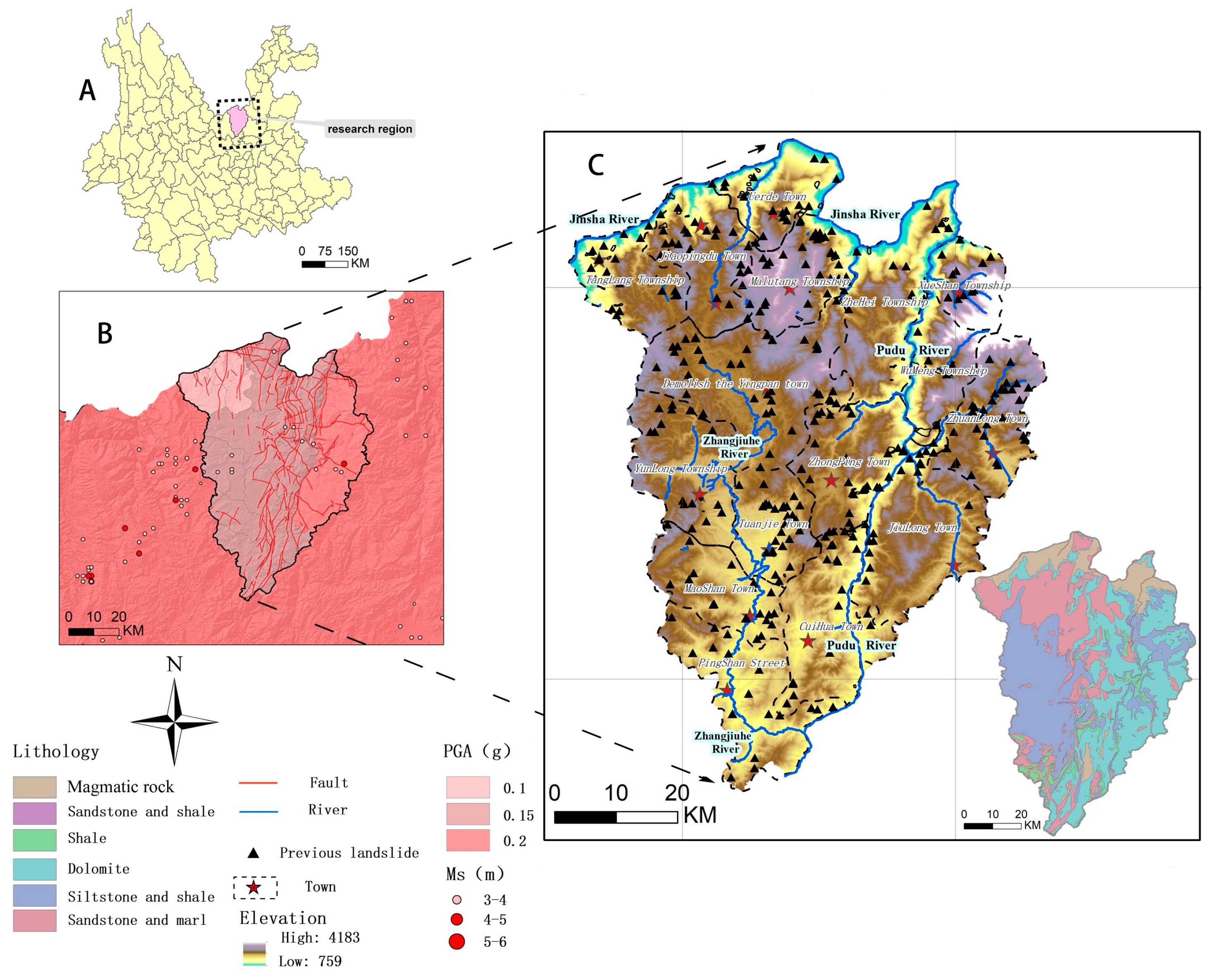
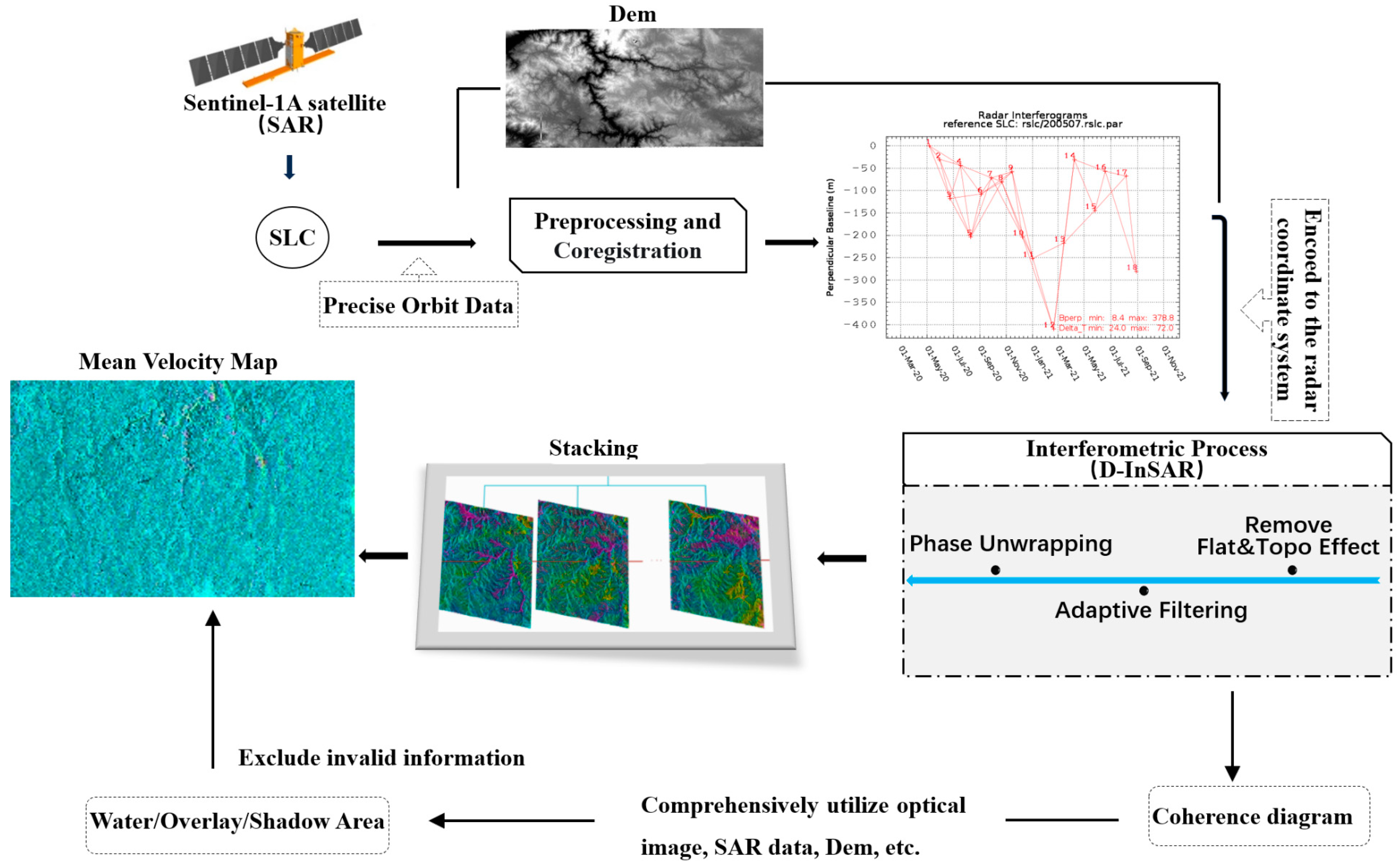
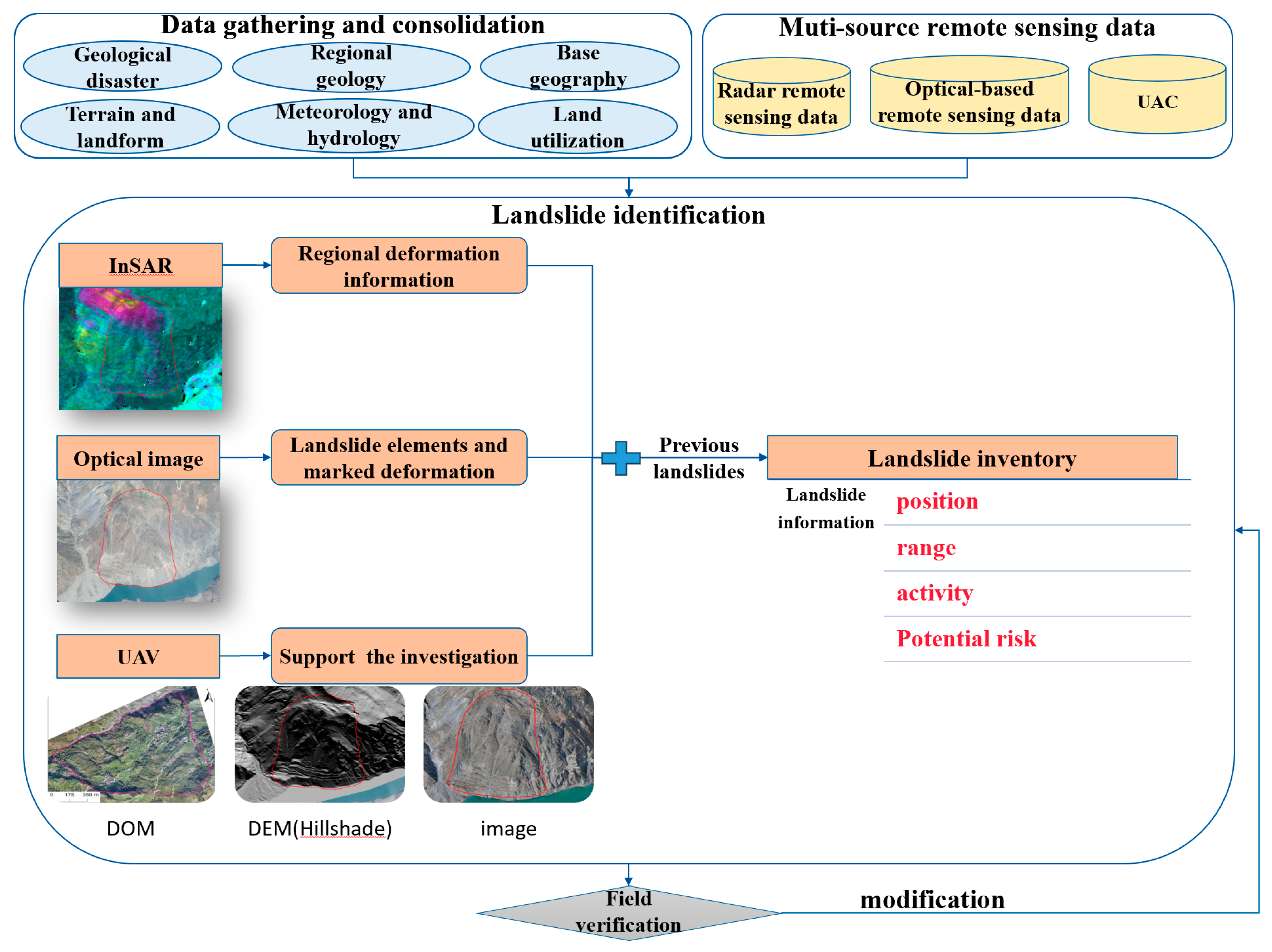


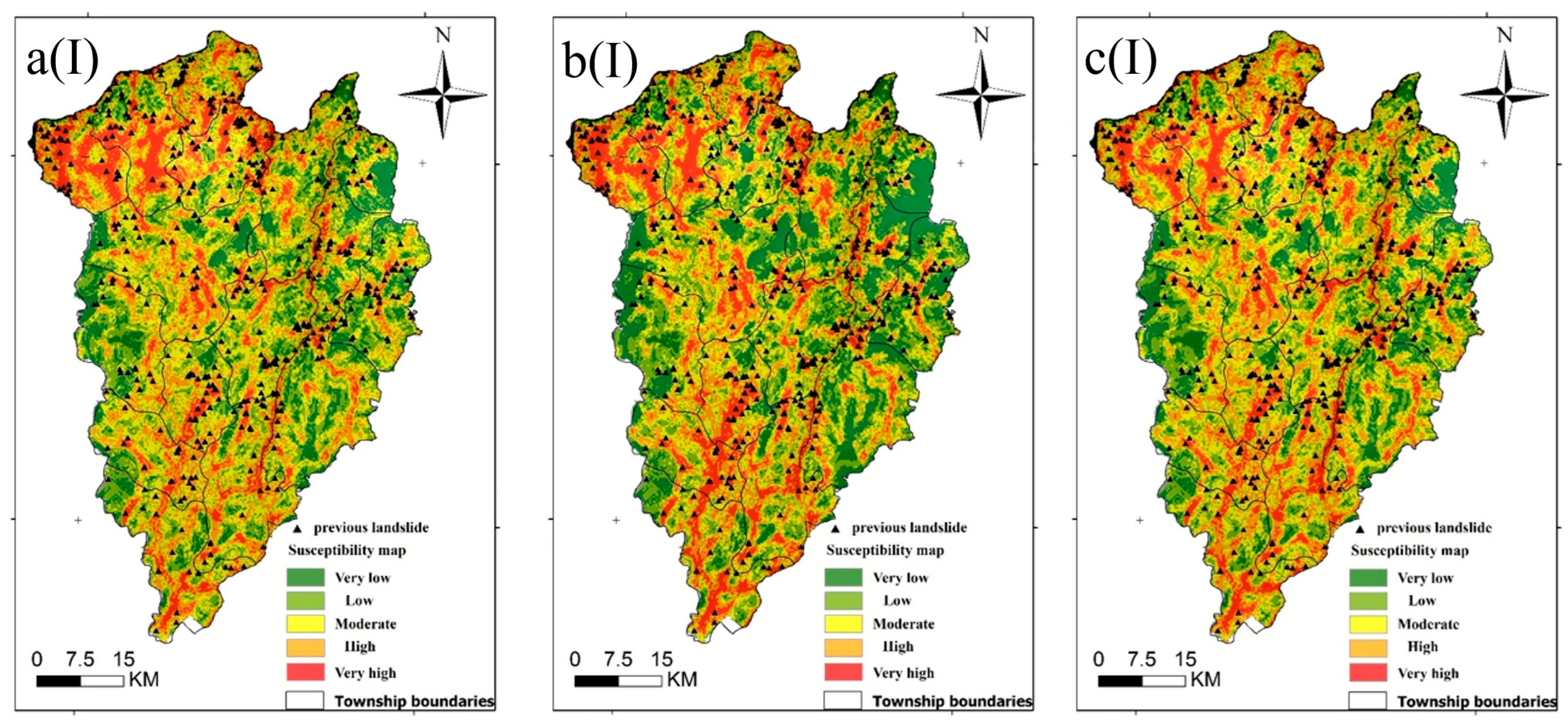
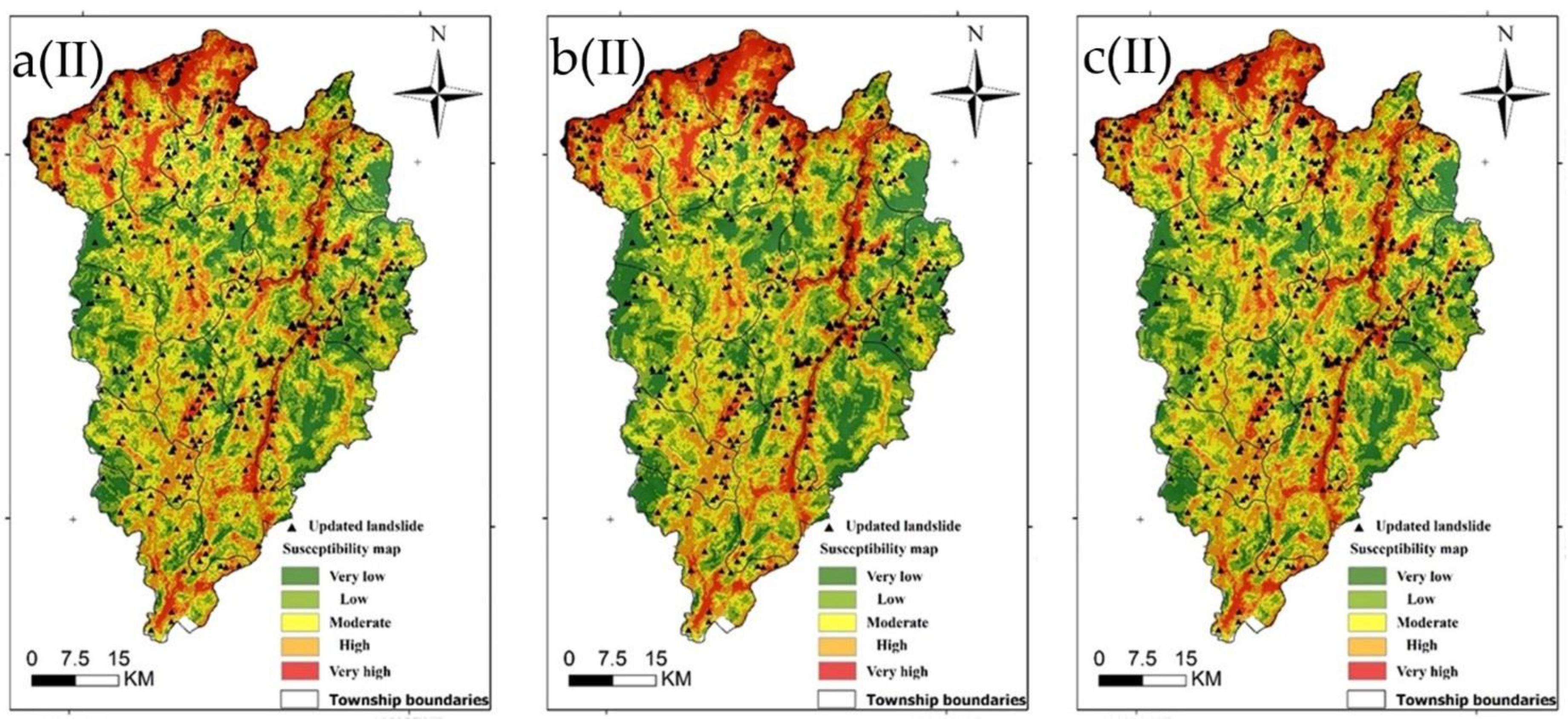



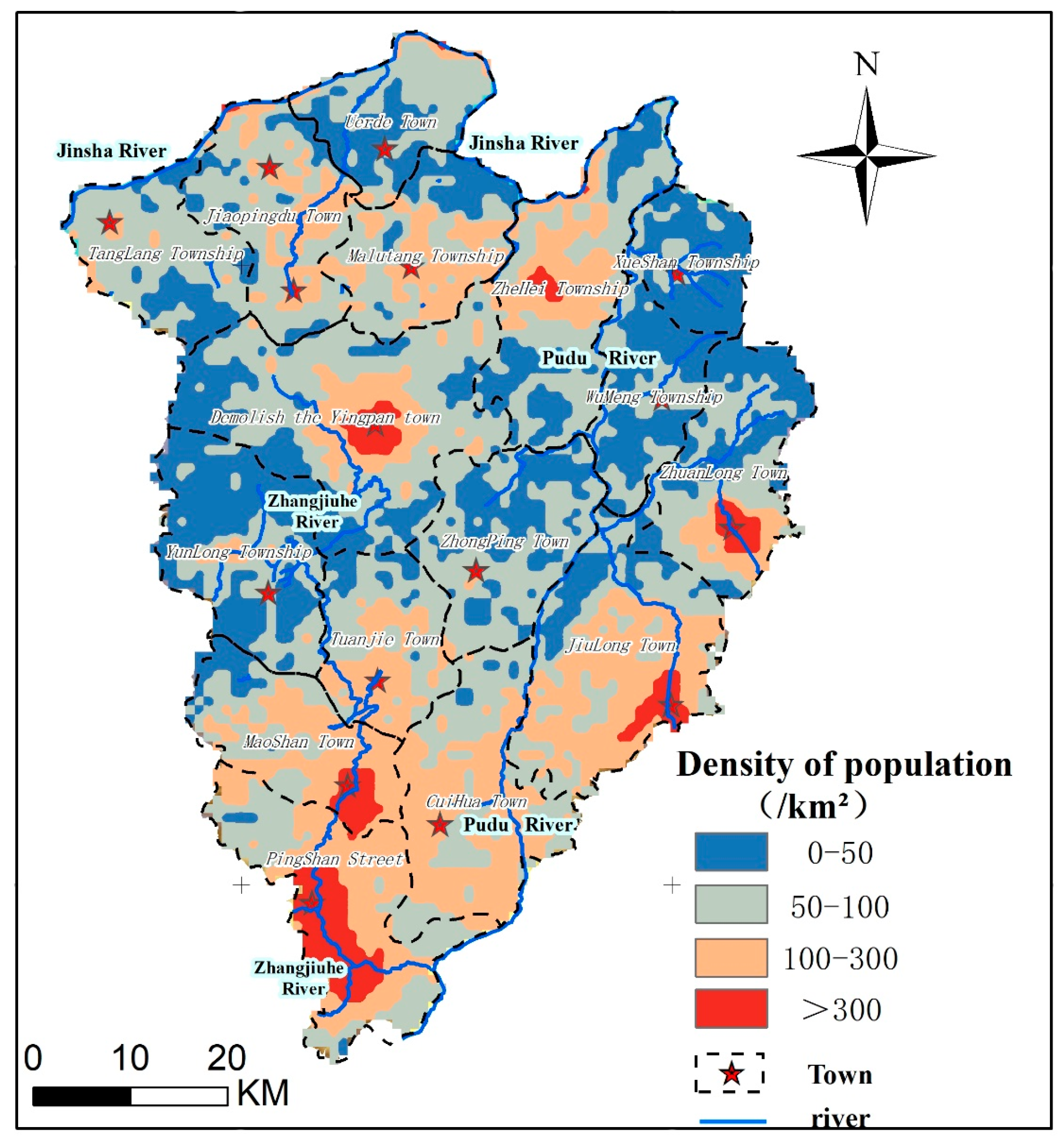
| Parameter | Value |
|---|---|
| Satellite | GF-2 (China) |
| Multitemporal optical images | 21 February 2020, 20 March 2020, 31 March 2020, 20 April 2020, 8 May 2020 |
| Panchromatic band resolution | 0.8 m |
| Multispectral resolution | 3.2 m |
| Revisit cycle | 1–2 days |
| Width of cloth | 24 km |
| Type | Predisposing Factors | Data Format | Source |
|---|---|---|---|
| Geological | Lithology | Vector | “Chinese stratigraphic table (2014)” and 1:50,000 regional geological map |
| Distance to the fault | Vector | ||
| Geomorphic | Elevation | Raster (30 m) | SRTM DEM 30 m (https://dwtkns.com/srtm30m/, accessed on 8 November 2023) |
| Slope | Raster (30 m) | ||
| Terrain undulation | Raster (30 m) | ||
| Hydrological | Distance to the main streams | Vector | AGRS |
| Distance to the tributary | Vector | ||
| Average annual precipitation | Raster (300 m) | Sourced from the study conducted by Wu et al. [17]. (Time period: 2002–2022) | |
| Anthropogenic | Distance to road | Vector | AGRS |
| Factors | TOL (I1) | VIF (I1) | TOL (I2) | VIF (I2) |
|---|---|---|---|---|
| X1 | 0.937 | 1.067 | 0.910 | 1.099 |
| X2 | 0.938 | 1.066 | 0.952 | 1.050 |
| X3 | 0.885 | 1.130 | 0.833 | 1.200 |
| X4 | 0.981 | 1.019 | 0.968 | 1.033 |
| X5 | 0.912 | 1.096 | 0.800 | 1.249 |
| X6 | 0.897 | 1.115 | 0.960 | 1.041 |
| X7 | 0.925 | 1.081 | 0.917 | 1.091 |
| X8 | 0.965 | 1.036 | 0.883 | 1.132 |
| X9 | 0.907 | 1.102 | 0.799 | 1.251 |
| Factor | Classes | NO. | Ii,j (I1) | Ii,j (I2) | Factor | Classes | NO. | Ii,j (I1) | Ii,j (I2) |
|---|---|---|---|---|---|---|---|---|---|
| X1 (m) | 0–200 | I11 | 0.999 | 1.000 | X5 (m) | <1000 | I51 | 0.445 | 0.694 |
| 200–400 | I12 | 1.000 | 0.929 | 1000–1500 | I52 | 0.734 | 1.000 | ||
| 400–600 | I13 | 0.808 | 0.816 | 1500–2000 | I53 | 1.000 | 0.899 | ||
| 600–800 | I14 | 0.587 | 0.538 | 2000–2500 | I54 | 0.813 | 0.668 | ||
| 800–1200 | I15 | 0.809 | 0.628 | 2500–3000 | I55 | 0.466 | 0.390 | ||
| 1200–1600 | I16 | 0.461 | 0.321 | >3000 | I56 | 0.000 | 0.000 | ||
| 1600–2000 | I17 | 0.498 | 0.410 | X6 (°) | 0–10 | I61 | 0.781 | 0.527 | |
| 2000–3000 | I18 | 0.401 | 0.261 | 10–20 | I62 | 1.000 | 1.000 | ||
| 3000–4000 | I19 | 0.518 | 0.218 | 20–30 | I63 | 0.842 | 0.759 | ||
| 4000–5000 | I110 | 0.552 | 0.287 | 30–40 | I64 | 0.832 | 0.938 | ||
| 5000–6000 | I111 | 0.989 | 0.703 | 40–50 | I65 | 0.545 | 0.605 | ||
| 6000–7000 | I112 | 0.501 | 0.374 | 50–60 | I66 | 0.000 | 0.021 | ||
| >70,000 | I113 | 0.000 | 0.000 | >60 | I67 | 0.586 | 0.000 | ||
| X2 (m) | 0–200 | I21 | 0.741 | 0.855 | X7 (m) | 0–50 | I71 | 0.150 | 0.000 |
| 200–400 | I22 | 1.000 | 1.000 | 50–100 | I72 | 0.726 | 0.578 | ||
| 400–600 | I23 | 0.749 | 0.973 | 100–150 | I73 | 0.743 | 0.632 | ||
| 600–800 | I24 | 0.000 | 0.198 | 150–200 | I74 | 0.706 | 0.614 | ||
| 800–1000 | I25 | 0.629 | 0.721 | 200–250 | I75 | 0.602 | 0.632 | ||
| 1000–1500 | I26 | 0.031 | 0.008 | 250–300 | I76 | 1.000 | 1.000 | ||
| 1500–2000 | I27 | 0.414 | 0.499 | 300–350 | I77 | 0.638 | 0.837 | ||
| >2000 | I28 | 0.018 | 0.000 | 350–400 | I78 | 0.547 | 0.764 | ||
| X3 (m) | Magmatic rock | I31 | 0.175 | 0.450 | >400 | I79 | 0.000 | 0.338 | |
| Sandstone and shale | I32 | 1.000 | 1.000 | X8 (m) | 0–800 | I81 | 0.806 | 1.000 | |
| Dolomite | I33 | 0.000 | 0.000 | 800–1600 | I82 | 0.609 | 0.899 | ||
| Siltstone and shale | I34 | 0.269 | 0.248 | 1600–2400 | I83 | 0.796 | 0.815 | ||
| Sandstone and marl | I35 | 0.381 | 0.403 | 2400–3200 | I84 | 0.518 | 0.620 | ||
| Shale | I36 | 0.189 | 0.213 | 3200–4000 | I85 | 0.287 | 0.356 | ||
| X4 (m) | 0–500 | I41 | 0.900 | 0.931 | 4000–4800 | I86 | 0.810 | 0.639 | |
| 500–1000 | I42 | 0.294 | 0.327 | 4800–5600 | I87 | 1.000 | 0.758 | ||
| 1000–1500 | I43 | 0.088 | 0.191 | >5600 | I88 | 0.000 | 0.000 | ||
| 1500–2000 | I44 | 0.229 | 0.400 | X9 (mm) | 922–948 | I91 | 0.045 | 0.000 | |
| 2000–2500 | I45 | 0.234 | 0.529 | 948–962 | I92 | 0.000 | 0.165 | ||
| 2500–3000 | I46 | 0.049 | 0.319 | 962–976 | I93 | 0.091 | 0.118 | ||
| 3000–4000 | I47 | 0.538 | 0.500 | 976–993 | I94 | 1.000 | 0.738 | ||
| 4000–5000 | I48 | 1.000 | 1.000 | 993–1023 | I95 | 0.220 | 1.000 | ||
| >5000 | I49 | 0.000 | 0.000 |
| Hyperparameters | I1 | I2 |
|---|---|---|
| C | 4.2 | 0.1 |
| penalty | l2 | l2 |
| max_iter | 20 | 20 |
| random_state | 33 | 33 |
| Hyperparameters | I1 | I2 |
|---|---|---|
| n_estimators | 200 | 168 |
| max_depth | 12 | 14 |
| min_samples_leaf | 4 | 2 |
| random_state | 33 | 33 |
| bootstrap | True | True |
| X1 | X2 | X3 | X4 | X5 | X6 | X7 | X8 | X9 | |
|---|---|---|---|---|---|---|---|---|---|
| I1 | 0.153 | 0.11 | 0.107 | 0.133 | 0.116 | 0.078 | 0.115 | 0.11 | 0.076 |
| I2 | 0.143 | 0.104 | 0.109 | 0.118 | 0.138 | 0.076 | 0.097 | 0.126 | 0.09 |
| Model | Level | Percentage of Graded Area (%) | Percentage of Landslides (%) | Density of Landslide (/100 km²) | |||
|---|---|---|---|---|---|---|---|
| I1 | I2 | I1 | I2 | I1 | I1 | ||
| IV | I | 12% | 13% | 2% | 3% | 0.016 | 0.026 |
| II | 24% | 24% | 11% | 10% | 0.038 | 0.046 | |
| III | 29% | 29% | 29% | 29% | 0.084 | 0.113 | |
| IV | 24% | 24% | 37% | 36% | 0.132 | 0.166 | |
| V | 11% | 10% | 20% | 22% | 0.154 | 0.237 | |
| GLR | I | 18% | 16% | 4% | 4% | 0.018 | 0.025 |
| II | 24% | 25% | 13% | 11% | 0.045 | 0.050 | |
| III | 24% | 27% | 24% | 31% | 0.087 | 0.125 | |
| IV | 21% | 21% | 30% | 32% | 0.123 | 0.166 | |
| V | 14% | 11% | 29% | 23% | 0.170 | 0.233 | |
| GWIV | I | 11% | 13% | 1% | 3% | 0.011 | 0.023 |
| II | 23% | 24% | 11% | 10% | 0.041 | 0.043 | |
| III | 29% | 29% | 27% | 31% | 0.079 | 0.119 | |
| IV | 25% | 24% | 37% | 34% | 0.124 | 0.160 | |
| V | 13% | 11% | 24% | 23% | 0.158 | 0.237 | |
| Indicators | GLR (I1) | GWIV (I1) | GLR (I2) | GWIV (I2) |
|---|---|---|---|---|
| Precision | 0.66 | 0.66 | 0.69 | 0.74 |
| Recall | 0.66 | 0.66 | 0.69 | 0.74 |
| F1-score | 0.66 | 0.66 | 0.69 | 0.74 |
Disclaimer/Publisher’s Note: The statements, opinions and data contained in all publications are solely those of the individual author(s) and contributor(s) and not of MDPI and/or the editor(s). MDPI and/or the editor(s) disclaim responsibility for any injury to people or property resulting from any ideas, methods, instructions or products referred to in the content. |
© 2024 by the authors. Licensee MDPI, Basel, Switzerland. This article is an open access article distributed under the terms and conditions of the Creative Commons Attribution (CC BY) license (https://creativecommons.org/licenses/by/4.0/).
Share and Cite
Lv, Z.; Wang, S.; Yan, S.; Han, J.; Zhang, G. Landslide Susceptibility Assessment Based on Multisource Remote Sensing Considering Inventory Quality and Modeling. Sustainability 2024, 16, 8466. https://doi.org/10.3390/su16198466
Lv Z, Wang S, Yan S, Han J, Zhang G. Landslide Susceptibility Assessment Based on Multisource Remote Sensing Considering Inventory Quality and Modeling. Sustainability. 2024; 16(19):8466. https://doi.org/10.3390/su16198466
Chicago/Turabian StyleLv, Zhuoyu, Shanshan Wang, Shuhao Yan, Jianyun Han, and Gaoqiang Zhang. 2024. "Landslide Susceptibility Assessment Based on Multisource Remote Sensing Considering Inventory Quality and Modeling" Sustainability 16, no. 19: 8466. https://doi.org/10.3390/su16198466
APA StyleLv, Z., Wang, S., Yan, S., Han, J., & Zhang, G. (2024). Landslide Susceptibility Assessment Based on Multisource Remote Sensing Considering Inventory Quality and Modeling. Sustainability, 16(19), 8466. https://doi.org/10.3390/su16198466






